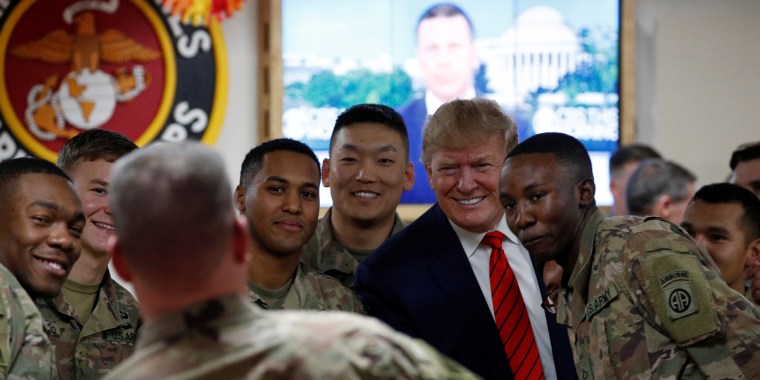“We are closer to war with Iran then we’ve been in the last 40 years,” former CIA chief Leon Panetta stated after the Trump administration killed Iranian general Qassem Soleimani. Indeed, Iran’s ambassador to the United Nations confirmed that in Iran’s view, the killing of Soleimani was an “act of war.” Last week, it was reported that Iran's Supreme Leader Ayatollah Ali Khamenei had ordered direct attacks on American interests in the region. In retaliation for the assassination, a military air base in Iraq's Al Anbar province housing U.S. troops was hit by rockets. Iran took responsibility.
While President Donald Trump tweeted after the attack that “all is well,” we still don’t know if the military skirmishes will eventually escalate. Iran, a nation of over 80 million people, is three times the population of Iraq in 2003 when the United States launched the Iraq War. On Thursday, a leader of Iran’s Revolutionary Guard threatened “harsher revenge soon.”
Many of those risking their lives for our nation come from the very same communities Trump has demeaned and even discriminated against.
But two things we do know. First, any military action by the U.S. will be fought in large part not by the wealthy but by those from lower- and middle-class families. And secondly, given that our military increasingly reflects the diversity of our nation, many of those risking their lives for our nation come from the very same communities Trump has demeaned and even discriminated against. Trump’s tweeted threats imperil the kinds of Americans he loves to demonize at MAGA rallies.
Rep. Alexandria Ocasio-Cortez, D-N.Y., summed up the inequality of war perfectly on Twitter on Friday. “War is a class conflict, too,” Ocasio-Cortez tweeted. “The rich and powerful who open war escape the consequences of their decisions. It’s not their children sent into the jaws of violence.”
“The rich and powerful” escaping the consequences of war, as the congresswoman points out, is nothing new. During the Vietnam War, Trump and many others from wealthy families were able to avoid being drafted — in large part thanks to their privilege. (Trump famously secured five deferments — including one for a rather curious case of bone spurs — to avoid being drafted.)
This idea that the lower and middle classes bear the brunt of war is backed up in a recent report by the Council on Foreign Relations, which examined the demographics of those who are serving in our all-volunteer military. The report notes that, “most members of the military come from middle-class neighborhoods,” with nearly 20 percent from families making below $38,000 a year.
In addition, a 2016 study titled, “Two Americas of Military Sacrifice,” concluded that, “unlike in World War II, the Americans who die or are wounded in war are disproportionately coming from poorer parts of the country.”
But socioeconomic motivators aside, it is more than a little ironic that so many American military members who pledge allegiance to the current U.S. commander in chief are nonwhite. Recent Pew data shows that 43 percent of men and 56 percent of women are now minorities, with Hispanics representing the fasting growing group.
Trump has made demonizing Latino immigrants one of the most visible parts of both his presidential campaign and his presidency. He literally kicked off his 2016 campaign by claiming (falsely) that Mexico was sending “rapists” and “drug dealers” to the U.S. Since then, he has continued to gin up fears by calling Hispanic migration “an invasion of our country” and labeling undocumented Hispanic immigrants as “thugs” and “animals.” His administration has deported U.S. military veterans of Hispanic heritage — despite their service to our nation.
Trump has also demeaned many visible black Americans, often furthering racist stereotypes in the process. The president’s vile attack on the late Rep. Elijah Cummings and the Baltimore district he represented as being “rat and rodent infested” was a notable lowlight.
Trump as a candidate claimed “Islam hates us.” Yet there are an estimated over 5,000 Muslim Americans serving in our military.
Trump as a candidate claimed “Islam hates us” and called for a “total and complete shutdown” of Muslims entering the country. Yet, there are over an estimated 5,000 Muslim Americans serving in our military. Muslims continue to fight and die representing and protecting the American flag in conflicts around the world, including in the Middle East.
Nobody wants our service members to have to put themselves in danger on our behalf. But a robust, well-trained military is an important part of our defense. Which is why it’s so confusing as to why Trump has spent so much time attempting to prevent transgender Americans from serving proudly and effectively. This despite a 2015 Department of Defense-sponsored study by the Rand Corporation that found allowing transgender Americans to serve in our military had “no impact on unit cohesion” or “operational effectiveness or readiness” and that commanders expressed that “a more inclusive and diverse” military force actually benefited all service members.
Trump talks a lot about how proud he is of our military. He also loves to issue threats — threats that would be ultimately carried out by others. Ultimately, his boasts ring hollow when he needlessly puts their lives in danger and when he demonizes their communities. Whether Trump likes it or not, America’s military is diversifying far faster than his worldview. Starting wars is easier than fighting in them. It’s clear which option our president prefers.


